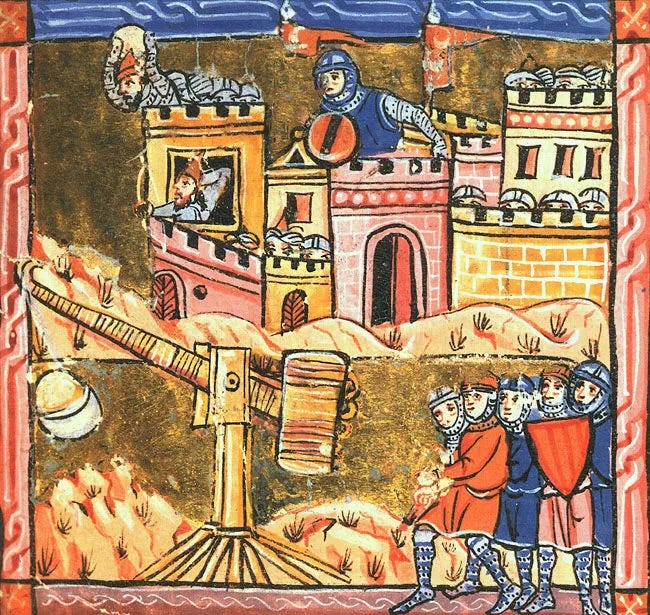Today in History: July 10-13
The Allies invade Sicily, Zheng He begins is "treasure voyages," and more
If you’re interested in history and foreign affairs, Foreign Exchanges is the newsletter for you! Sign up for free today for regular updates on international news and US foreign policy, delivered straight to your email inbox, or subscribe and unlock the full FX experience:
PROGRAMMING UPDATE: As I hope you all know, Foreign Exchanges is on a break that is scheduled to end on July 18. I hope you’re all doing well, and look forward to resuming our regular programming in a few days. Thanks for reading!
July 10, 1943: In a pre-dawn landing the Allies begin their invasion of Sicily, codenamed “Operation Husky.” Although it wasn’t until mid-August that Sicily was in Allied hands the Italian military began evacuating forces from the island in late July, and the seemingly inevitable defeat proved to be the last straw for Benito Mussolini’s government, which fell on July 25. The Sicilian operation marked the first phase of the Allied invasion of Italy.
July 10, 2017: Iraqi authorities declare the city of Mosul liberated from the Islamic State, marking the recapture of the last major city in Iraq that had still been in IS’s hands. Two more large campaigns followed in Tal Afar and Hawija, but once Mosul was retaken the outcome of the campaign against IS in Iraq was no longer in doubt.
July 11, 1405: Chinese admiral Zheng He sets sail on the first of his “treasure voyages.” Between 1405 and 1433 Zheng led his fleets to destinations around Southeast Asia and across the Indian Ocean, visiting India, the Persian Gulf, the Red Sea, and East Africa. There’s even some creative pseudo-history out there that argues he visited South America and Europe, though the “evidence” for these claims is either non-existent or invented. The voyages ended as suddenly as they began, for reasons that still aren’t entirely clear but probably involved the restoration of older Ming Dynasty policies that had been overridden by the Yongle Emperor (d. 1424).
July 11, 1995: The Srebrenica massacre begins. Bosnian Serb forces killed almost 8400 Bosniak men and boys in and around Srebrenica over the next couple of weeks, and carried off an estimated 25,000-30,000 women, children, and elderly.
July 12, 1191: The Crusader Siege of Acre ends with a technical Crusader victory that set the stage for the ultimate failure of the Third Crusade. Begun in 1189 by Guy of Lusignan, the titular “King of Jerusalem” who by this point was no longer actually king of Jerusalem (or anywhere else, for that matter), the siege quickly became a potential disaster for the Crusaders when Saladin arrived with a large relief army. But Saladin failed to lift the siege, and the 1191 arrival of new European armies led by Philip II of France and Richard I of England turned the tide. However, disputes between the two kings prompted Philip to pack up and head home once Acre’s garrison had surrendered, and the remaining army under Richard was too small to achieve the expedition’s main objective of retaking Jerusalem.
July 12, 1575: At the Battle of Rajmahal, the Mughal Empire eliminates the Karrani Dynasty, capturing and executing its final ruler Daud Khan Karrani, and annexes the Sultanate of Bengal.
July 13, 1878: The Treaty of Berlin (temporarily) settles the “Great Eastern Crisis” over Russia’s threat to the Ottoman Empire. The treaty superseded the earlier Treaty of San Stefano, which ended the 1877-1878 war between Russia and the Ottomans but was so lopsided in Russia’s favor that Britain and France felt compelled to step in and quash it. The Berlin do-over recognized the independent states of Montenegro, Romania, and Serbia and an autonomous (effectively independent) Bulgaria. It shrunk Bulgaria down from the size envisioned under San Stefano and forced the Russians to return some territory to the Ottomans. Austria-Hungary was allowed to effectively annex Bosnia and Herzegovina, which it formally annexed in 1908.
July 13, 1977: The Somali National Army, working with a rebel group called the Western Somali Liberation Front, invades Ethiopia, beginning the Ogaden War. Basically the Somalis thought they could take advantage of a moment of internal weakness in Ethiopia to seize the predominantly Somali Ogaden. As both countries were Soviet clients at the time, Moscow had a decision to make, and it chose Ethiopia. With Soviet aid and Cuban reinforcements, the Ethiopians turned the tide and pushed the SNA back into Somalia by March 1978. Somalia then shifted its Cold War allegiance to the United States.


